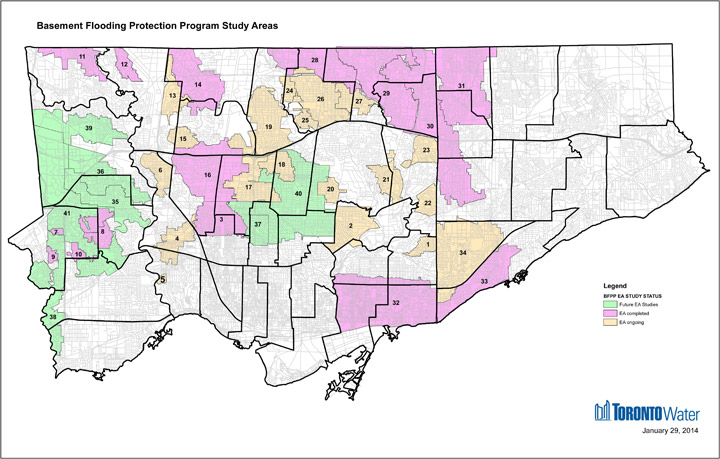Watch the video above: Warmer weather and massive snow piles could lead to flooding in the GTA. Peter Kim reports.

TORONTO – Temperatures are expected to warm up mid-week which means the temporary winter thaw may cause flooding in certain Toronto neighbourhoods.
With the amount of snow recorded so far in February, city officials are reminding residents and homeowners to be aware of any flooding issues and to call 311 if you experience any water leakage in your basement.
According to the City of Toronto website, basement flooding is caused by a number of reasons including a crack in your home’s foundation, poor lot grading or drainage, overflowing eavestroughs, blocked connection between the home and the main sewer in the street or a back-up of wastewater in the sewer system.
The city is currently in the process of conducting environmental assessments of 34 chronic basement flooding areas in various neighbourhoods.
So far, improvements to the city’s sewage infrastructure began as of the fall of 2009. This includes storm and/or sanitary sewer upgrades, construction of dry ponds and underground storage tanks.
To further assist homeowners, the city offers owners of single-family, duplex and triplex residential homes a financial subsidy of up to $3,400 per property to install flood protection devices.
But since the July 8, 2013 flood, more than 4,000 applications have been received which has resulted in a 20-week processing backlog.
However, there are still ways you can reduce the risk of flooding in your home. The City of Toronto has these tips for you:
What you can do outside the house
- Seal cracks or openings in walls, floors, windows and foundations, and seal all window wells.
- Clear eavestroughs and downspouts of leaves and other debris that prevent proper drainage.
- Disconnect your downspouts from the sewer system, where feasible.
- Make sure your disconnected downspouts are draining properly, ideally two metres (six and a half feet) from your foundation’s walls.
- Ensure the grading around your home slopes away from the foundation wall to help drain water away from your home (without negatively affecting neighbouring properties).
- Increase the green space around your home with native plants and shrubs and install porous pavement to help absorb rainwater and melted snow.
- Repair/replace damaged weeping tile systems.
- Clear debris from roadside catchbasins (grates) to help water enter the stormsewer. (If it is safe to do so.)
- Ensure drainage swales (shallow ditch) between properties are maintained and clear of obstructions.
What you can do inside the house
- Ensure that your plumbing is in good working condition. Homeowners are responsible for the plumbing from the property line to inside the home. The City is responsible for the public portion of the service line.
- Hire a City-licensed and qualified plumber to install a backwater valve and a properly-sized sump pump and piping.
- Ensure the proper and regular maintenance of basement flooding devices in your home.Sump pumps need power to operate, so consider installing a back-up power source.
- Consider installing shelves to help keep items off the floor in your basement. Also, avoid keeping valuables or important documents in the basement. If you do, keep them in a watertight/water-resistant container.
- Avoid carpet in the basement, which retains water and is harder to clean up.
- Dispose of small amounts of cooking oil and grease in your green bin, not down the drain, which can cause a drain blockage. (Make sure there is absorbent material in the bin).
- Avoid flushing objects down the toilet, such as dental floss, condoms, tampons, razor blades, non-biodegradable products, etc., which can block the sanitary pipe.
Source: City of Toronto Stormwater Management
- Mother’s Day Miracle: Rare medical intervention saves high-risk pregnancy for Ontario woman
- Mayor says Ottawa will reverse course on Israel national day event after cancellation
- TSX edges off recent record after blowout jobs report, U.S. stock markets mixed
- Teenage boy arrested after stabbing on Pickering, Ont. bus




Comments